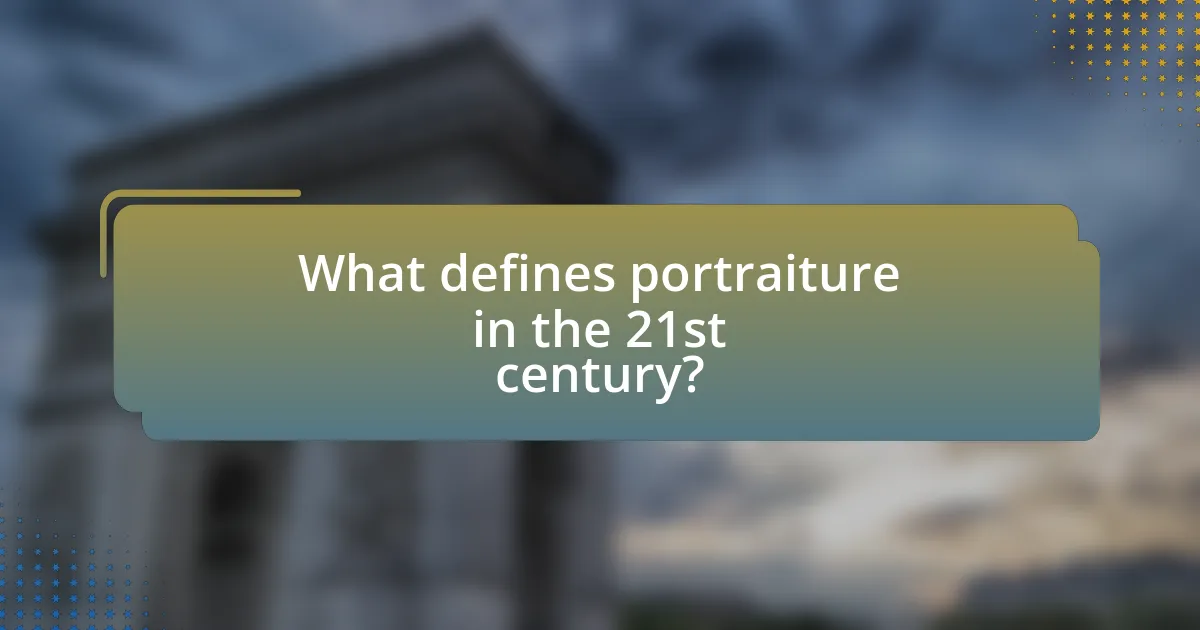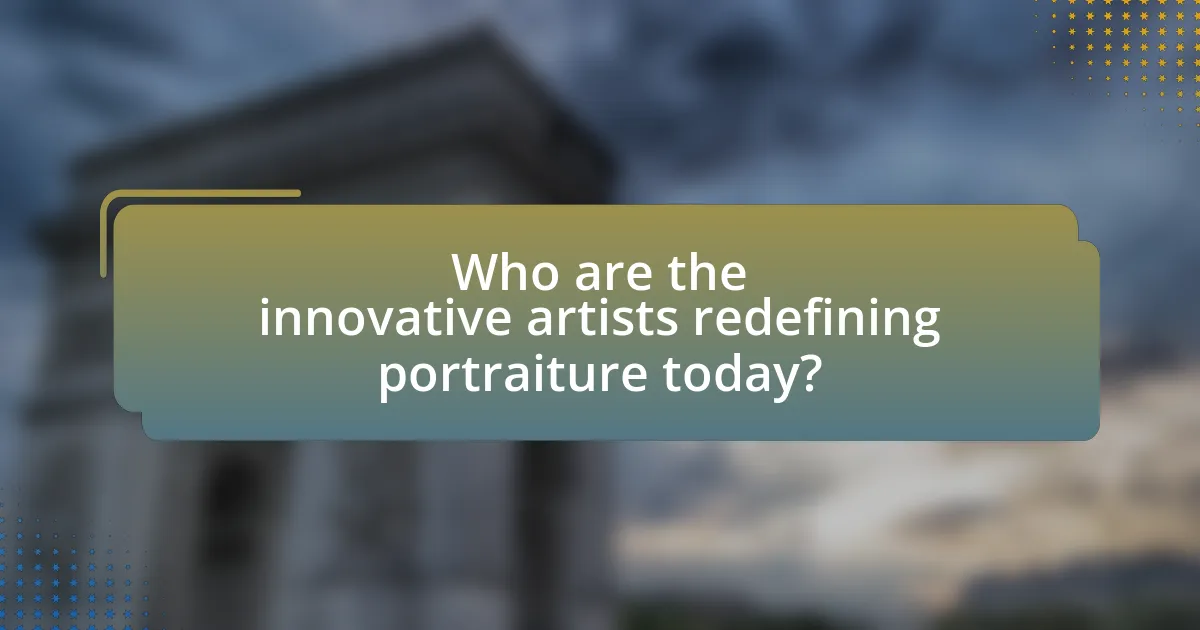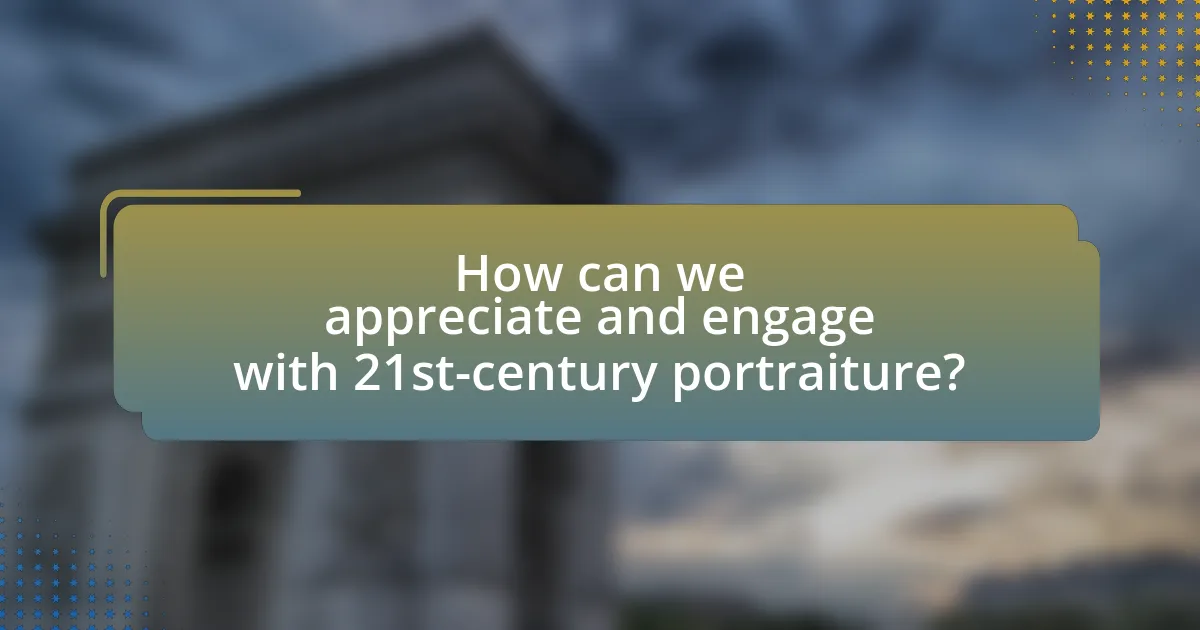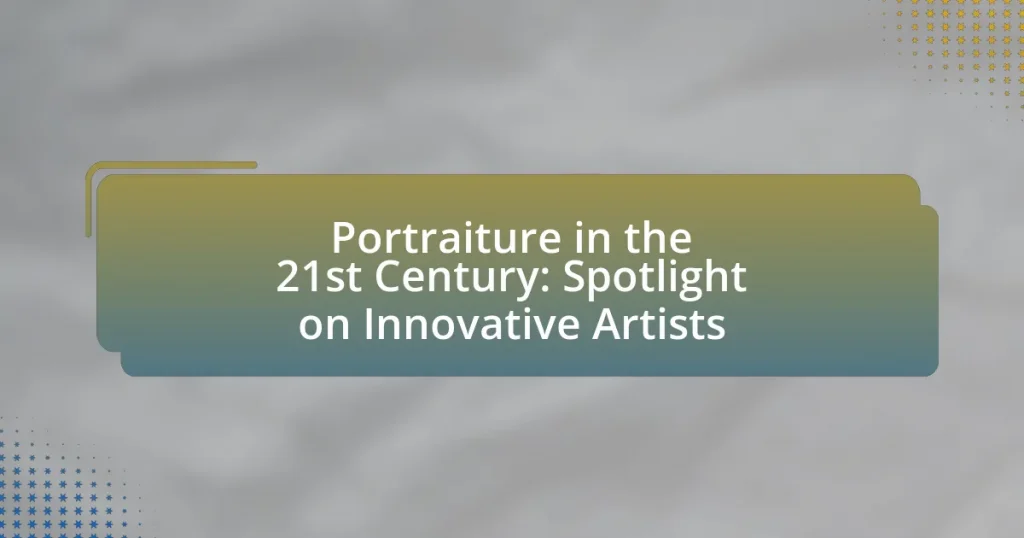Portraiture in the 21st century is characterized by its diverse representation of identity, utilizing various mediums such as photography and digital art to explore themes of race, gender, and personal narrative. Contemporary artists like Kehinde Wiley and Amy Sherald challenge traditional notions of portraiture by recontextualizing historical references and engaging with contemporary social issues. The article examines the evolution of portraiture, the impact of cultural shifts, and the innovative techniques employed by modern artists, highlighting the importance of identity and social commentary in their work. Additionally, it discusses how technology and social media influence the creation and appreciation of contemporary portraits, providing insights into the key characteristics and themes prevalent in today’s portraiture.

What defines portraiture in the 21st century?
Portraiture in the 21st century is defined by its diverse representation of identity, incorporating elements such as technology, social commentary, and cultural context. Contemporary artists utilize various mediums, including photography, digital art, and mixed media, to explore themes of race, gender, and personal narrative, reflecting the complexities of modern society. For instance, artists like Kehinde Wiley and Cindy Sherman challenge traditional notions of portraiture by recontextualizing historical references and engaging with contemporary issues, thus validating the evolving nature of this art form.
How has the concept of portraiture evolved in recent years?
The concept of portraiture has evolved significantly in recent years, shifting from traditional representations to more diverse and inclusive interpretations. Contemporary artists now explore identity, culture, and technology, often incorporating mixed media and digital elements to challenge conventional notions of self-representation. For instance, the rise of social media has influenced portraiture, with platforms like Instagram allowing for new forms of self-portraiture that emphasize personal narrative and authenticity. Additionally, artists such as Kehinde Wiley and Amy Sherald have gained recognition for their work that recontextualizes historical portraiture by centering marginalized identities, thereby expanding the dialogue around race and representation in art. This evolution reflects broader societal changes and the ongoing quest for inclusivity in visual culture.
What historical influences shape contemporary portraiture?
Contemporary portraiture is shaped by historical influences such as the Renaissance emphasis on realism, the Baroque focus on emotional expression, and the modernist movement’s exploration of identity. The Renaissance period introduced techniques like chiaroscuro and linear perspective, which enhanced the three-dimensionality and lifelike quality of portraits. The Baroque era further influenced portraiture by prioritizing dramatic lighting and emotional depth, as seen in the works of artists like Rembrandt. Additionally, modernist movements challenged traditional representations, incorporating abstract elements and diverse perspectives on identity, which are evident in the works of contemporary artists like Kehinde Wiley and Cindy Sherman. These historical influences collectively inform the techniques, themes, and approaches found in today’s portraiture.
How do cultural shifts impact modern portrait artists?
Cultural shifts significantly impact modern portrait artists by influencing their subject matter, style, and the mediums they choose. For instance, the rise of social media has led artists to explore themes of identity and representation, reflecting contemporary societal issues such as race, gender, and sexuality. Artists like Kehinde Wiley and Amy Sherald have gained prominence by challenging traditional notions of portraiture and incorporating diverse narratives that resonate with current cultural dialogues. Additionally, the increasing acceptance of digital art forms has allowed portrait artists to experiment with new technologies, expanding their creative possibilities and audience reach. This evolution in artistic expression is evident in exhibitions and art fairs that prioritize inclusivity and contemporary relevance, showcasing how cultural dynamics shape the landscape of modern portraiture.
What are the key characteristics of 21st-century portraiture?
The key characteristics of 21st-century portraiture include a focus on identity, diversity, and the integration of technology. Artists in this era often explore complex themes of race, gender, and culture, reflecting a broader societal understanding of identity. For instance, contemporary portraitists like Kehinde Wiley and Amy Sherald challenge traditional representations by highlighting underrepresented communities, thus promoting inclusivity. Additionally, the use of digital media and photography has transformed portraiture, allowing for innovative techniques and new forms of expression, as seen in the works of artists like Cindy Sherman, who employs digital manipulation to explore self-identity. These characteristics demonstrate how 21st-century portraiture is not only a reflection of individual subjects but also a commentary on societal dynamics.
How do technology and digital media influence portrait creation?
Technology and digital media significantly influence portrait creation by enabling artists to utilize advanced tools and platforms for enhanced expression and accessibility. Digital cameras and software allow for high-resolution images and intricate editing capabilities, which can transform traditional portrait techniques. For instance, programs like Adobe Photoshop provide artists with the ability to manipulate images extensively, creating unique styles that were previously unattainable. Additionally, social media platforms facilitate the sharing and promotion of portrait art, allowing artists to reach wider audiences and engage with communities globally. This democratization of art has led to diverse interpretations and innovations in portraiture, reflecting contemporary societal themes and personal narratives.
What role does identity play in contemporary portraiture?
Identity plays a crucial role in contemporary portraiture by serving as a lens through which artists explore and express personal, cultural, and social narratives. This exploration often reflects the complexities of modern identity, including aspects such as race, gender, sexuality, and socio-economic status. For instance, artists like Kehinde Wiley and Zanele Muholi utilize portraiture to challenge traditional representations and highlight marginalized identities, thereby fostering dialogue about inclusivity and representation in art. Their works exemplify how contemporary portraiture can act as a powerful medium for identity affirmation and social commentary, reinforcing the idea that identity is not only a personal construct but also a collective experience that shapes societal perceptions.

Who are the innovative artists redefining portraiture today?
Innovative artists redefining portraiture today include Kehinde Wiley, Amy Sherald, and Zanele Muholi. Kehinde Wiley is known for his vibrant, large-scale portraits that challenge traditional representations of Black individuals in art. Amy Sherald gained recognition for her unique style and was commissioned to paint Michelle Obama’s official portrait, emphasizing the importance of representation. Zanele Muholi focuses on the LGBTQ+ community in South Africa, using photography to highlight identity and social issues. These artists are reshaping the genre by incorporating contemporary themes and diverse perspectives, thus expanding the boundaries of portraiture.
What notable contemporary portrait artists should we know about?
Notable contemporary portrait artists include Kehinde Wiley, Amy Sherald, and Chuck Close. Kehinde Wiley is renowned for his vibrant, large-scale portraits that often depict people of color in poses traditionally reserved for European art, challenging historical narratives. Amy Sherald gained prominence for her striking portraits that explore African American identity, notably painting Michelle Obama’s official portrait. Chuck Close is celebrated for his photorealistic works and innovative techniques, despite facing significant physical challenges. These artists have significantly influenced contemporary portraiture, each bringing unique perspectives and styles to the genre.
What unique techniques do these artists employ in their work?
These artists employ unique techniques such as digital manipulation, mixed media, and interactive installations in their portraiture work. For instance, digital manipulation allows artists to blend traditional painting with photography, creating surreal and layered images that challenge perceptions of identity. Mixed media techniques, which incorporate materials like fabric, paper, and found objects, add texture and depth, enhancing the emotional impact of the portraits. Additionally, interactive installations invite viewer participation, transforming the experience of portraiture into a dynamic dialogue between the artwork and the audience, exemplified by artists like Rafael Lozano-Hemmer, who uses technology to engage viewers in real-time.
How do these artists challenge traditional notions of portraiture?
These artists challenge traditional notions of portraiture by redefining identity and representation through innovative techniques and diverse mediums. For instance, contemporary portraitists often incorporate mixed media, digital technology, and unconventional materials, which disrupt the classic oil-on-canvas approach. Additionally, they explore themes of gender, race, and social issues, reflecting a broader spectrum of human experience that traditional portraiture often overlooks. This shift is evident in the works of artists like Kehinde Wiley, who recontextualizes historical portraiture by placing people of color in positions of power, thereby challenging the Eurocentric standards of beauty and representation.
What themes are prevalent in the works of these innovative artists?
Innovative artists in 21st-century portraiture frequently explore themes of identity, technology, and social commentary. Identity is often examined through diverse representations that challenge traditional notions of race, gender, and culture, reflecting the complexities of contemporary society. Technology plays a significant role, with artists utilizing digital mediums and social media to reshape how portraits are created and consumed, thus altering viewer engagement. Social commentary is prevalent as artists address pressing issues such as inequality, mental health, and environmental concerns, using their work to provoke thought and inspire dialogue. These themes collectively illustrate the evolving nature of portraiture in response to modern societal dynamics.
How do social issues influence their artistic expression?
Social issues significantly influence artistic expression by shaping the themes, subjects, and techniques artists choose to explore. For instance, artists often address topics such as inequality, identity, and political unrest, using their work as a platform for social commentary. A notable example is the work of contemporary portrait artist Kehinde Wiley, who challenges traditional representations of race and power by depicting people of color in poses historically reserved for white subjects in classical portraiture. This approach not only highlights social disparities but also reclaims narratives around identity and representation. Furthermore, research indicates that artists who engage with social issues often experience a deeper connection with their audience, as their work resonates with shared societal experiences and challenges.
What personal narratives are reflected in their portraits?
The personal narratives reflected in their portraits often encompass themes of identity, culture, and emotional experiences. For instance, contemporary artists frequently use their work to explore personal histories, societal issues, and the complexities of self-representation. This is evident in the portraits that incorporate elements of the artist’s background, such as ethnicity or gender, which serve to communicate their unique perspectives and lived experiences. Additionally, the use of symbolism and color in these portraits can convey deeper emotional states, illustrating the artist’s internal struggles or triumphs. Such narratives are validated by the increasing recognition of diverse voices in the art world, highlighting the importance of personal storytelling in contemporary portraiture.

How can we appreciate and engage with 21st-century portraiture?
To appreciate and engage with 21st-century portraiture, individuals can explore diverse artistic styles and mediums that reflect contemporary themes and societal issues. Engaging with works by innovative artists such as Kehinde Wiley, who reinterprets classical portraiture by featuring people of color in grand historical poses, allows viewers to connect with the evolving narrative of identity and representation. Additionally, attending exhibitions, participating in discussions, and utilizing digital platforms to view and share portraits can enhance understanding and appreciation of the cultural context and techniques employed by modern portrait artists. This engagement fosters a deeper connection to the artwork and its relevance in today’s society.
What are effective ways to analyze contemporary portraits?
Effective ways to analyze contemporary portraits include examining the use of color, composition, and subject matter. Analyzing color can reveal emotional undertones and the artist’s intent, as seen in the vibrant palettes of artists like Kehinde Wiley, who uses bold colors to challenge traditional representations. Composition analysis helps understand the arrangement of elements within the portrait, which can convey power dynamics or social commentary, as demonstrated in the works of Amy Sherald, who often places her subjects in striking poses against patterned backgrounds. Additionally, exploring the subject matter allows for insights into cultural and societal themes, such as identity and representation, which are prevalent in contemporary portraiture. For instance, the focus on marginalized communities in the works of artists like Zanele Muholi highlights issues of visibility and empowerment.
How can viewers interpret the messages behind modern portraits?
Viewers can interpret the messages behind modern portraits by analyzing the visual elements, context, and the artist’s intent. Modern portraits often incorporate symbolism, color theory, and composition to convey deeper meanings about identity, culture, and societal issues. For instance, artists like Kehinde Wiley use vibrant colors and historical references to challenge traditional representations of race and power. This approach allows viewers to engage with the artwork on multiple levels, prompting discussions about contemporary social dynamics. Additionally, the use of mixed media and unconventional materials in modern portraiture can further enhance the narrative, inviting viewers to consider the broader implications of the subject matter.
What elements should be considered when critiquing portrait art?
When critiquing portrait art, key elements to consider include composition, use of color, emotional expression, technique, and context. Composition refers to the arrangement of subjects and elements within the artwork, which can significantly impact the viewer’s perception. The use of color affects mood and can convey deeper meanings; for instance, warm colors may evoke feelings of warmth and intimacy, while cool colors can suggest distance or calmness. Emotional expression is crucial, as it reflects the subject’s personality and the artist’s intent, often engaging the viewer on a personal level. Technique encompasses the artist’s skill and methods, which can vary widely and influence the overall effectiveness of the portrait. Lastly, context involves understanding the cultural, historical, and social background of the artwork, which can provide insight into its significance and the artist’s message. These elements collectively contribute to a comprehensive critique of portrait art.
What resources are available for exploring innovative portrait artists?
Resources for exploring innovative portrait artists include online platforms, art galleries, and social media. Websites like Artsy and Saatchi Art feature contemporary portrait artists and their works, providing access to a wide range of styles and techniques. Additionally, museums such as the National Portrait Gallery and the Museum of Modern Art often host exhibitions focused on innovative portraiture, showcasing both established and emerging artists. Social media platforms like Instagram and Pinterest allow users to discover and follow innovative portrait artists directly, facilitating engagement with their latest works and projects. These resources collectively offer a comprehensive view of the current landscape of portraiture in the 21st century.
How can exhibitions and online platforms enhance our understanding of portraiture?
Exhibitions and online platforms enhance our understanding of portraiture by providing diverse contexts and interpretations of the art form. Physical exhibitions allow viewers to engage with artworks in person, facilitating a deeper emotional connection and appreciation for the techniques and materials used by artists. For example, the National Portrait Gallery in London showcases a range of contemporary portraiture, allowing visitors to explore the evolution of styles and themes over time. Online platforms, such as Artsy and Instagram, democratize access to portraiture by enabling artists to share their work globally, fostering dialogue and collaboration among audiences and creators. This accessibility broadens perspectives on identity and representation, as seen in the viral success of portrait artists like Kehinde Wiley, whose work challenges traditional notions of portraiture. Together, these avenues create a multifaceted understanding of portraiture that reflects cultural shifts and individual narratives.
What role do social media and digital galleries play in promoting artists?
Social media and digital galleries are crucial in promoting artists by providing platforms for visibility and engagement. These tools enable artists to showcase their work to a global audience, facilitating direct interaction with potential buyers and fans. For instance, platforms like Instagram and Pinterest allow artists to share images of their artwork, while digital galleries like Saatchi Art and Artsy provide curated spaces for sales and exhibitions. According to a survey by the National Endowment for the Arts, 72% of artists reported that social media significantly increased their visibility and opportunities for sales. This demonstrates the effectiveness of these digital platforms in enhancing an artist’s reach and marketability.
What tips can help aspiring artists create impactful portraits?
Aspiring artists can create impactful portraits by focusing on strong composition, effective use of light, and capturing genuine emotion. Strong composition involves arranging elements within the frame to guide the viewer’s eye and create balance, which is essential for drawing attention to the subject. Effective use of light enhances the mood and depth of the portrait; for instance, Rembrandt lighting creates dramatic effects that can evoke emotion. Capturing genuine emotion requires artists to connect with their subjects, allowing for authentic expressions that resonate with viewers. Research indicates that portraits that convey emotion are more likely to engage audiences, as demonstrated in studies on viewer response to emotional content in art.














